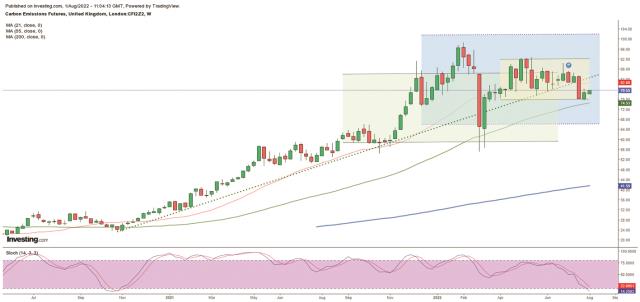By Frank O. Brannvoll, Brannvoll ApS, Denmark
Carbon prices tested the downside, due to fear of demand destruction and potential closing of production sites as a consequence of the lower gas deliveries. In addition to inflation, higher interest rates may dampen demand. However, in the short-term coal production has been increasing and several countries will reopen coal plants and even diesel is being used, increasing the demand for EUAs.
Traders sold out when the price broke support at EUR80, driving financial players to sell out.
August and September are thin trading months with little news from Brussels and many trading houses are on holiday, resulting in a low liquidity that may lead to high volatility.
Analysts estimate the increase of coal burn in 2023 will increase demand by just 30-35m EUAs in the EU.
The EUA December 2022 price fell to EUR79 and is now in a lower range of EUR77-88 (see Figure 1). The all-time high of EUR98.50 is not to be challenged in the next months.

Figure 2: EUA front-year contract, July 2020-August 2022
The main elements discussed in the European Council for fourth quarter are:
• increase in the linear reduction factor (LRF) to 4.2 from 2.2 per cent from 2024
• reduction of 177m allowances in 2024
• keep the Market Stability Reserve (MSR) intake at 24 per cent, not reducing it to 12 per cent in 2024
• phase out free allowances by introducing the carbon border adjustment mechanism (CBAM) between 2026-35.
For 2022 Brannvoll ApS forecasts a trading range of EUR65-100, with an average of EUR80.
